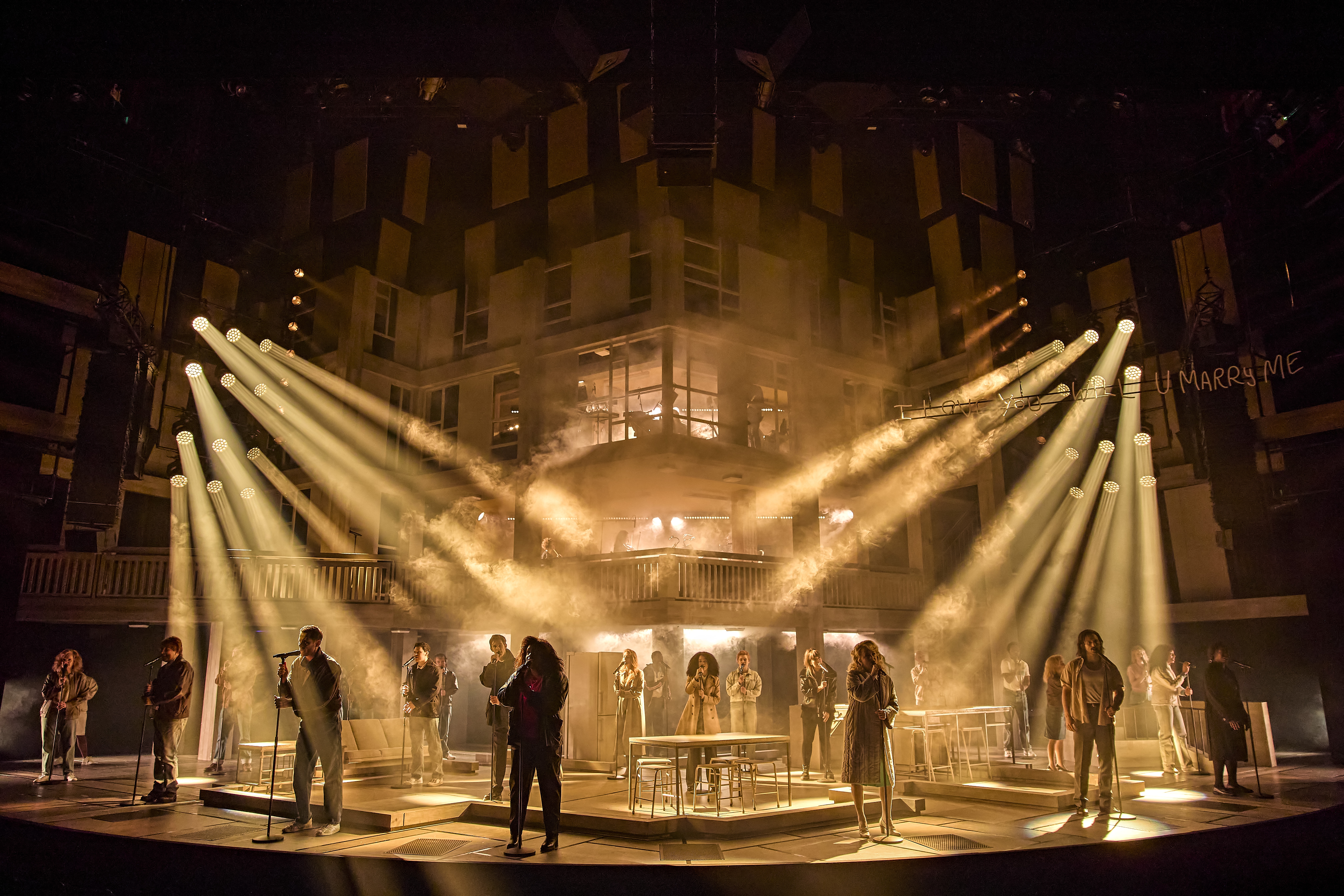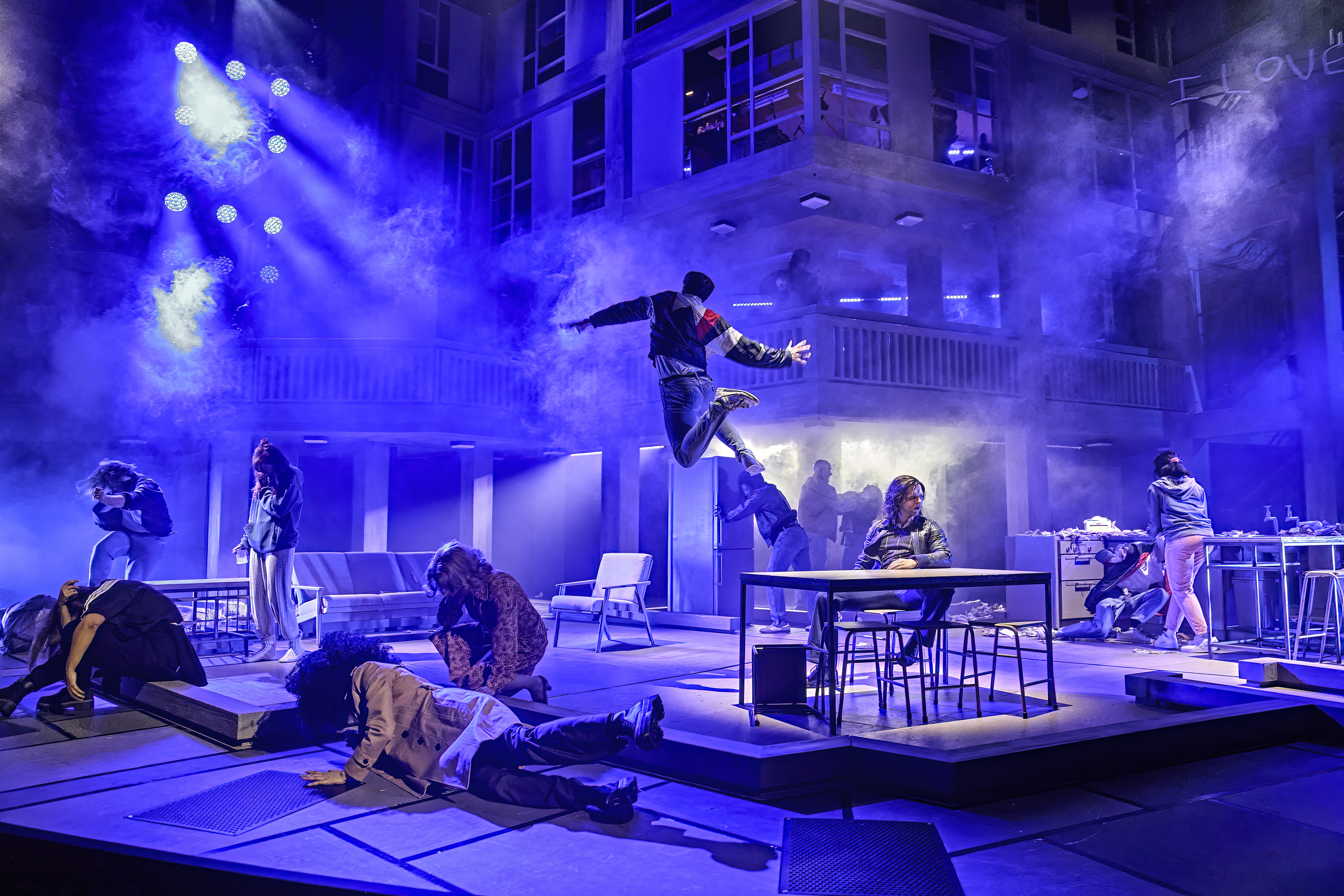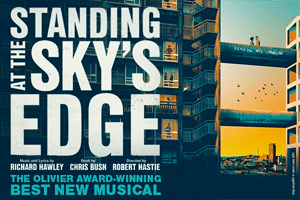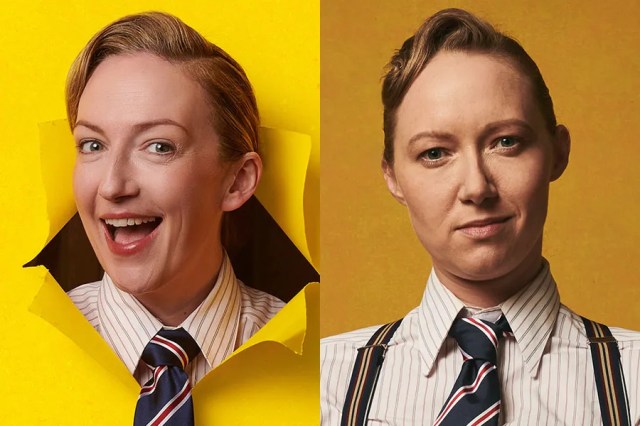Turning a Skyscraper Into a Musical: The Origin of the West End Hit Standing at the Sky’s Edge
Writer Chris Bush and director Robert Hastie discuss the origin of this Olivier Award-winning musical at the Gillian Lynne Theatre.
Musical theater is not monolithic, and yet, a monolith comes to life in the Olivier Award-winning West End musical Standing at the Sky’s Edge at the Gillian Lynne Theatre. Written by Chris Bush and featuring the music of UK singer-songwriter Richard Hawley, Standing at the Sky’s Edge is set within a single apartment in the Park Hill housing complex in the city of Sheffield over the course of several decades. Representing the totality of post-War Britain, it follows three families who all inhabit the same unit over different generations, with Hawley’s evocative songs revealing each character’s emotional interior.
Standing at the Sky’s Edge comes to the West End after a premiere run at Sheffield Theatres and a further run at the National Theatre in 2023. With Bush on the creative team is director Robert Hastie (the artistic director of Sheffield Theatres), who has shepherded the show across the multiple venues. Here, they discuss the creation of this massive musical, and why its story of family and home will resonate no matter where it’s performed.

(© Brinkhoff/Moegenburg)
This conversation has been condensed and edited for clarity.
I saw Standing at the Sky’s Edge based on great word of mouth, not knowing anything about it, like that it’s a jukebox musical. I didn’t even know who Richard Hawley was, but I’m fully obsessed now.
Robert Hastie: I’m glad to have made another Richard Hawley convert.
Chris Bush: The fact that Richard isn’t a household name in the same way that Michael Jackson is, almost buys you more creative freedom. There’s less preciousness around that as a starting point, which is lovely as a writer. He is a genius, and when I came onto this project, I knew his work, but I didn’t know his back catalog intimately. I don’t know what people expect the music of Sheffield to sound like, but it’s probably not quite Richard’s stuff. It feels like he’s so steeped in a tradition of Americana, and it has this rockabilly aesthetic.
Robert: You can feel the connection to his place and his people profoundly in his music. He goes over a lot of people’s heads, and that’s partly just because there is a certain refusal to play the game, or a willingness to play the game to a point. He’s not comfortable being on the road too long away from Sheffield.
Chris: I think, at this point, he genuinely doesn’t care about how commercial he is, but he cares deeply about the work that he makes. In that playing the game thing, yeah, I don’t think he seeks any wider level of accolades than what he already has.
Robert: I do think he’s really enjoying this success.
Is the approach of creating a jukebox musical different than writing one from scratch?
Chris: You approach it in a totally different fashion. I think jukebox musicals go off the rails when you try to pretend that the pop songs you have are musical theater songs. They’re not built to do the same job. They don’t do narrative progression in the same way. Richard’s genius is in giving you just enough of a world in the sparse poetry of his lyrics, which gives you a lot of space to fill in the gaps.
The pitch that I inherited was that it’s Richard’s music and the story of the Park Hill housing estate, which sits in Sheffield and dominates the skyline of the city center. Within that frame, there was free reign. Because that estate has something like 1,000 units, you can tell any story you want. Sometimes, it was just a case of listening to different albums on repeat and seeing what speaks out. With something like “Our Darkness,” I had this idea of miners going back to work after the strike of 1985, and this combination of a big moment in political history while a personal relationship is in turmoil. That’s certainly not what was in Richard’s mind when he wrote the song, but that was the world it conjured up for me.
It’s a give-and-take in terms of how you cut the cloth, how you let the music speak and influence the story and making sure that your narrative has enough flexibility to fully allow the songs to steer you. I don’t say this disparagingly, but it’s not the Mamma Mia! approach of trying to make the lyrics speak very specifically to the story all the time. It can be a bit more suggestive than that.
Robert: If we tried to put these songs into Mamma Mia!, they’d just fall apart. The lyrics won’t hold. The lyrics had to mean less, and the story had to mean more than in most musicals. There had been an earlier attempt to turn these songs into a standard musical with a different writer, a different director, and it hadn’t worked. Everybody abandoned that and then Chris and I picked it up when I took over as the artistic director of the Sheffield Crucible. I think the sense we got was that they hadn’t figured out earlier that the songs couldn’t behave like that kind of musical.

(© Brinkhoff-Moegenburg)
Did you always envision it as this massive production with a literal representation of Park Hill onstage, even though it takes place in one single apartment over three sets of tenants?
Chris: In the three iterations it has had, from Sheffield to the National to the West End, the set has got increasingly monolithic and solid. In Sheffield, it’s more of a deep open stage where the set sort of disappeared into the ceiling. Now at the Gillian Lynne, it feels like the estate itself goes on forever. It feels more physically imposing.
Robert: I can’t remember exactly when we knew that it was going to be the same flat rather than three different flats.
Chris: It was early on, in consultation with Ben Stones, our amazing designer. I think I knew from day one that it was going to be three different, distinct timelines that interweave, but maybe that meant a revolve with a third of a living room there, and a third there. Then we realized that that was never going to use the space in the best possible way. As soon as we realized that it could be one single flat, that the location could stay fixed, and the chronology could be the thing that moved, with multiple scenes playing on top of each other, it unlocked everything dramatically for how the show operates. I liked the idea that you could knock down the walls and get an entirely different set of households and lives, but it would still be the story of postwar Britain, within this massive, monolithic estate.
In some ways, it could also be a deeply American story, if you were to bring it here. You wouldn’t need to change the setting to, say, Chicago.
Chris: One of the most beautiful things is how much the city of Sheffield has taken this show to their hearts. It has come with a fierce sense of ownership. In the first production, we would have people going, “They’ll never understand this in London.” And then we took it to London and people said, “Well, they’ll never get it in America.” But it’s totally universal. You don’t need to set it in Brooklyn to understand that there are estates, housing projects, everywhere, with changing demographics in a country where there are extremes of wealth and poverty. In essence, the show is about the significance of home, both physically and spiritually, and that is a totally universal thing.









